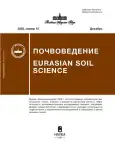The chemical composition and properties of surface soil horizons (0–10 cm) and PM10 fractions in three cities in northern Western Siberia (Novy Urengoy, Nadym, and Noyabrsk) were studied. The content of Al, Fe, Sc, V, Cr, Co, Ni, Cu, Zn, As, Sr, Mo, Sn, Sb, Cs, Ba, W, Pb, Bi, and U were determined by atomic emission spectrometry and inductively coupled plasma mass spectrometry. It was shown that the average content of potentially toxic elements in urban soils is lower than the average values for the upper part of the Earth’s crust. The contents of Pb, Zn, Sb, and Sn in PM10 particles are 4–16 times higher than the bulk values in soils. In Novy Urengoy, PM10 particles are enriched with Sb and Zn, in Nadym – Sb, Zn, Pb, Ni, Cu, V, and in Noyabrsk – Sb, Zn, Ni, Pb, Cu. Based on the EF values of elements in PM10 particles, broader associations of pollutants are identified. W, As, Sn, Bi, Mo, and Cu appear in the pollution profile. In all cities, Sb and Zn have the highest EF values. The most contrasting Sb anomalies are characteristic of road intersections and transport infrastructure facilities. According to the total enrichment factor, urban soils have an average level of pollution, while PM10 particles have a high level, with Ni, Zn, W, and Cu contributing the most. The PCA method identified the main sources of elements. The formation of the Ni–Co–Cr–W association is linked to the lithogenic component, while the Ba–Pb–Cs association is related to the organic matter. All cities are characterized by the accumulation of Zn, Sb, Cu, Pb, and Mo, an association that indicates the major role of motor vehicles in the contamination of urban soils.
 1637–1653
1637–1653


 1654-1668
1654-1668


 1669–1691
1669–1691


 1692–1706
1692–1706


 1707–1733
1707–1733


 1734-1751
1734-1751


 1752–1768
1752–1768


 1769-1782
1769-1782


 1783-1795
1783-1795


 1796-1815
1796-1815


 1816-1830
1816-1830


 1831-1846
1831-1846


 1847-1862
1847-1862


 1863-1877
1863-1877


 1878-1890
1878-1890












